The Christmas Album
-
Mr. Arkadin
- Posts: 2645
- Joined: April 14th, 2007, 3:00 pm
Europa 51 and Viaggio in Italia are indeed masterworks (along with Stromboli [1950]). Unfortunately these movies are still unknown and unappreciated by many of Bergman's fans. Viaggio in Italia is available in region 2, but the other two films are OOP. I'd like to think that Criterion or BFI could release these films in a box set someday. Until then, your best bet at finding them is to check the TCM listings where they are shown about once a year (if that often).
- moira finnie
- Administrator
- Posts: 8024
- Joined: April 9th, 2007, 6:34 pm
- Location: Earth
- Contact:
Thanks, Nancy. It's been a lot of fun to hunt down some of these interesting, occasionally amusing and sometimes touching photos of classic faves at the holidays. I do think that guy on Ingrid's right looks a bit like Joseph Cotten, but he looks much thinner and about 25-30 years of age to me, which was considerably younger than Mr. C., but, since he was in the Selznick stable too, maybe he went along. I don't believe Cotten was in the service, but do know that when traveling for the USO some entertainers wore uniforms of a sort.
Hi Ark,
I'd like to hope that those films are going to show up someday on dvd, but I've found dvds that were out of print on the internet that are quite affordable and are watchable when one wants to see something. It isn't that ideal boxed set you or I might wish for, but they are around. And, of course, one's friends often help too. I hope that you're doing well. It's always good to hear from you.
Hi Ark,
I'd like to hope that those films are going to show up someday on dvd, but I've found dvds that were out of print on the internet that are quite affordable and are watchable when one wants to see something. It isn't that ideal boxed set you or I might wish for, but they are around. And, of course, one's friends often help too. I hope that you're doing well. It's always good to hear from you.
- moira finnie
- Administrator
- Posts: 8024
- Joined: April 9th, 2007, 6:34 pm
- Location: Earth
- Contact:
The Christmas Album: Myrna

The Seventh Day of our Holiday tour finds us sharing a cup of seasonal cheer with Myrna Loy and the Navy during the Second World War, which began for America on another Sunday 67 years ago today, December 7th at Pearl Harbor.
Giving up her acting career during the war to devote herself to Red Cross work, (except for The Thin Man Goes Home), Ms. Loy might prefer to be remembered for work such as this, her championing of civil rights, (asking impertinent questions on the MGM lot as to why no African-American ever appeared with a briefcase instead of a broom in any courthouse scenes), and later as an active U.N. supporter, but we can still cherish her for her playfulness, humor and warmth, all on great display in The Thin Man movies. The original movie of the series features one of the great introduction scenes in movie history as Nora (Loy) literally falls from art deco grace thanks to that naughty Asta tugging at his leash trying to get nearer to Nick and all that booze; causing Christmas presents, furs, gloves and dignity to splay across the ritzy barroom floor. No matter how beleaguered, Loy kept a firm grip on her aplomb.
The soubriquets as "the perfect wife", (after four failed tries in reality, she would wince at that, though she was an ideal screen partner), or the "Queen of Hollywood", which was a press agent's honorific given to her and the "King of Hollywood", Clark Gable. Mr. G., she reported in her discreet autobiography, Being and Becoming, landed in the bushes one night after she gave him a shove off her front porch, blocking a fumbled pass on his part, though they remained pals. William Powell, whom many fans of their outings as Nick and Nora Charles, assumed was her husband, was simply her dear friend.

Above: Though the outfit makes it hard to tell, that's early, exotic Myrna swathed in the height of fashion in some neighborhoods in the '20s, a velvet coat trimmed in fur, and that swiss cheese headgear. The reindeer looks suspiciously uninterested in that hamburger (or Christmas present?) that Ms. Loy is holding.
Of her film roles, ranging from exotic Oriental babes to continental adventuresses to All-American women, some of my personal picks might be Countess Valentine in Love Me Tonight, Coco, the consummate mistress in Topaze, and, as the abiding force behind Fredric March in The Best Years of Our Lives and Cary Grant in Mr. Blandings Builds His Dream House. For all her early exotic forays on screen and her sophistication, her muted work portraying a ranch woman in The Red Pony may have been closest to her own Montana roots. Her often forgotten work in character parts vividly portraying troubled women such as the wife of Robert Ryan in Lonelyhearts and as Paul Newman's besotted mother in From the Terrace were exceptionally good, though utterly overlooked. Myrna could make even in a lousy movie, such as Just Tell Me What You Want, worth watching, as she brought fifty years of acting skill to grace a small but finely crafted throwaway part.
One fellow that she carried on an epistolatory flirtation with before and during the war that divided her work life in two was FDR."We carried on a long-distance infatuation throughout World War II," she recalled. "He was always sending me telegrams, trying to get me to come to Washington. But I could never go when he was there. The times I did get there, he was gone. It's a very sad story." After thinking it over, she remarked with a small smile, "Probably very lucky."
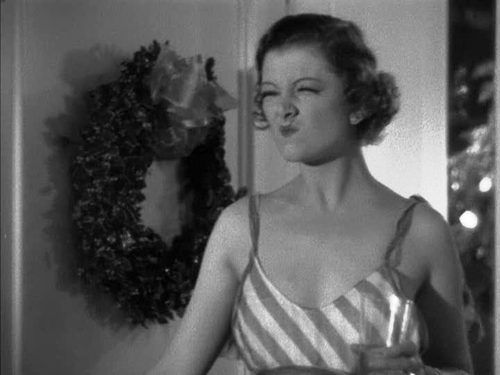
Above: Myrna Loy as the playful Nora Charles, a memorable role from The Thin Man (1934) and other films in the series.
- moira finnie
- Administrator
- Posts: 8024
- Joined: April 9th, 2007, 6:34 pm
- Location: Earth
- Contact:
A Christmas Album: Der Bingle

Day Eight of our Holiday time trip lands us just outside the Palm Terrace in the Beverly Hills Hotel in 1952, in time to catch crooner Bing Crosby with his beard askew prior to a Christmas lunch for the Women's Press Club. His relaxed presence and conversational singing style developed along with the microphone and radio, allowing him to form a bond with his listeners that lasted for some 40+ years. Coming on the heels of anemic tenors with an artificiality that today seems deadly, Crosby trained his voice to become a remarkable instrument sounding the way we all think we might sound singing around the house. As his friend and collaborator Louis Armstrong described it, his "voice has a mellow quality that only Bing's got. It's like gold being poured out of a cup."
Over time, that gold got thinner, and, for many, turned to lead with post mortem revelations about a seemingly cold private demeanor, a troubled first marriage and children whose lives went awry, followed by present day commentators misinterpreting the casual air for indifference. Fortunately, Gary Giddins' splendid biography, Bing Crosby: A Pocketful of Dreams, pointed out some truths that are worth recalling about this vocal innovator. Others recognized his innate ability to blend jazz elements into his work. This allowed him to translate that bluesy streak in American music into a highly commercial, acceptable happy-go-lucky format. Some, who recognized Crosby as musically one of the hippest white men around, acknowledge that he opened the door to all those whose fame followed and were encouraged by the man. Among them were Frank Sinatra, Dean Martin, Tony Bennett, Nat King Cole and Mr. Armstrong, whose career on screen and in recording studios reflected Crosby's color blindness in the face of talent. His influence faded with the arrival of rock music, yet younger people, when rediscovering Bing and his music, still feel the pull of the lost America that he sprang from--a country of small towns and hopes, that the singer addressed without irony as "Dear Hearts and Gentle People". Music might bridge the economic and racial realities for a few moments as he raised his voice to sing of "Pennies From Heaven", "Danny Boy", "The Cool, Cool, Cool of the Evening", and, of course, "White Christmas", to name but a few of his anthems.
To those of us who came years after his nearly monstrous fame of the war years, he may seem a puzzle, but his voice, whether scatting with the Rhythm Boys of Paul Whiteman's Orchestra or his deceptively casual take on Cole Porter's "I Love You, Samantha" from High Society (1956), can still touch a chord in this listener. His films, which he began to make as soon as sound arrived, crooning "When the Folks High-Up Do the Mean Low-Down" in a Douglas Fairbanks, Sr. film, Reaching For the Moon (1930), he began to learn to translate that relaxed air into something special on screen. Early appearances in Going Hollywood (1933), We're Not Dressing (1934), Mississippi (1935) and Sing You Sinners (1938) helped to formulate his screen persona as an amiable, often directionless young man who stumbled into fame thanks to a God-given gift for vocalizing.
His lasting screen presence took on a comic edge when he began working with his longtime partner, Bob Hope in 1940's Road to Singapore, followed by six more "Road" movies--all variations on the first. On the surface, Crosby was the likably vain straight man who was a little on the con opposite Hope's comical easy mark and resident schlemiel. Thanks to their writers working overtime and their own improvisational skills, the sense of fun between them has not aged badly. This may be in part because, while constantly breaking that fourth wall in their movies, they made the audience feel hipper in their presence.
A personal favorite film for me came with the adaptation of Mark Twain's A Connecticut Yankee in King Arthur's Court (1949). Dramatic appearances in films, peaking with the cloying depictions of priesthood in director Leo McCarey's Going My Way (1944) and The Bells of St. Mary's (1945) were boffo box office, but his best acting may have come in Little Boy Lost (1953), The Country Girl (1954) and Man On Fire (1957). These latter films seem to blend self pity with a sense of nostalgia for an imagined set of ideal relationships by his characters. That these movies coincided with the period of his wife, Dixie Lee's illness and death may just be a coincidence, though I doubt it.
Of his throwaway style and talent he once said, "Honestly, I think I've stretched a talent which is so thin it's almost transparent over a quite unbelievable term of years." Turn on the radio anytime this month. You'll hear that surprisingly durable talent still holding sway over their listeners' emotions.
- moira finnie
- Administrator
- Posts: 8024
- Joined: April 9th, 2007, 6:34 pm
- Location: Earth
- Contact:
The Christmas Album: Joan
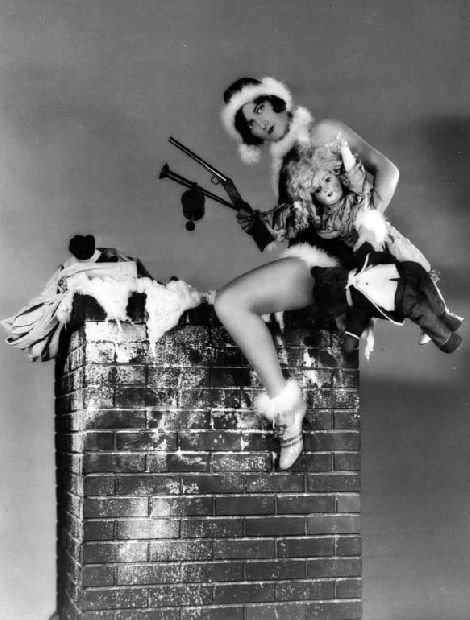
Blazing a wintry trail through the Holidays on Day Nine, we discover that the recently christened Joan Crawford, aka Lucille LaSueur, the lady with the fiercely determined look on her face above, has arrived in Hollywood, in the second half of the Roaring Twenties, loaded for bear. Joan, who seems to have a firm grip on her disheveled doll and her handy rifle, may be contemplating how far she's had to come and how much farther she had yet to go in her climb to get to the top of that chimney and the Hollywood heap. Born into extreme poverty in Texas, the actress would, through just such grit and the refinement of nature's raw materials, rise to the peak of fame.
The late silent era took the frenetic, big-eyed dancer on her first dance with her lifelong partner, Fame, with her first credited film significantly named Proud Flesh (1925). This was followed by such energetic forays as Our Modern Maidens (1929) and the early talkie, Dance, Fools, Dance (1931). Occasionally, in moments in films that were sometimes box office failures and more often successes, her work approached true artistry. Among those movies in which her yearning nature found more complete expression were the early talkie, Clarence Brown's Possessed (1931), Rain (1932), (which she deemed a failure, though she is at her finest in this Lewis Milestone movie of the Maugham vehicle) director George Cukor's A Woman's Face (1942), Michael Curtiz's adaptation of James M. Cain's Mildred Pierce (1945), the conflicted woman in Jean Negulesco's Humoresque (1946) and, perhaps her best acting in the second Possessed (1947). While many Joan fans relish her late career campiness, especially in the loonier turns it took, such as Torch Song (1953), Johnny Guitar (1954), Whatever Happened to Baby Jane (1962) and Strait-Jacket (1964), this viewer tends to draw a discreet veil over that Grand Guignol phase, preferring her when she still played a recognizable human, with some unknowable private pain and hope still in her, giving her often overly rich characterizations a vibrant tie to real life.
You would never know it by this early example of movie star publicity above, but Crawford's face was literally her fortune, and fiercely beautiful to look at when cleansed of mask-like makeup, and accompanied by a simpler hairstyle than this crimped number and seedy looking Santa hat. Even Joan, who was often more concerned with the surface rather than the substance of her rather lonely station perched above it all, eventually conceded, in a moment of honesty, that "I am just too much." God rest ye, Merry Joan, wherever you are.
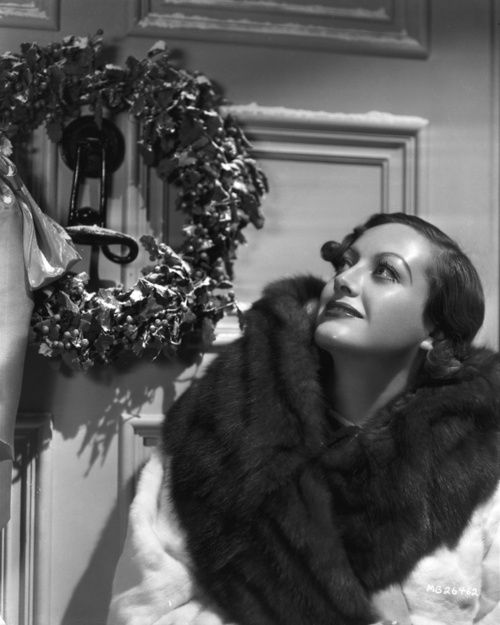
Above: A sleeker Joan Crawford a few years later than the first picture, looking much more self-assured (and warmer).
Last edited by moira finnie on December 9th, 2008, 10:52 am, edited 1 time in total.
- Ann Harding
- Posts: 1246
- Joined: January 11th, 2008, 11:03 am
- Location: Paris
- Contact:
Thanks for this lovely thread, Moira! Actually, I was lucky enough to see Proud Flesh (1925) an interesting Vidor silent. But I must admit that I did not notice dear Joan in it....Her part must be terribly small. The 'Proud Flesh' of the title refers to Eleanor Boardman as the proud and conceited Fernanda. 
-
jdb1
Re: The Christmas Album: Joan
Yipes. You're not kidding, Moira. Mannish look of the 1940s and beyond notwithstanding, this may be the ugliest photo of Crawford I've ever seen. Just goes to show how she had the skill to make herself into whatever was needed to become a Movie Star.moirafinnie wrote: You would never know it by this early example of movie star publicity above, but Crawford's face was literally her fortune, and fiercely beautiful to look at when cleansed of mask-like makeup, and accompanied by a simpler hairstyle than this crimped number and seedy looking Santa hat. God rest ye, Merry Joan, wherever you are
- moira finnie
- Administrator
- Posts: 8024
- Joined: April 9th, 2007, 6:34 pm
- Location: Earth
- Contact:
The Christmas Album: The Babe

Day Ten of our Holiday hit parade finds us visiting a dominant figure who straddled the world of sports and entertainment for decades in American society, surpassing all in his and our time: Babe Ruth, seen above as Santa Claus. The place is the Astor Hotel in New York City on the 17th of December, 1947. The occasion is a Christmas party for children with polio given by the Sister Kenny Foundation. That's Jimmy McCall, age three on his lap, and Jane Greenfield hovering at his knee.
Mr. Ruth ceased playing ball in 1935 before these kids were even gleams in their fathers' eyes, but it's likely that the older kids understood that he was something special. Over a three decade career in pro baseball, he had a career batting average of .342, and 714 home runs to his credit, a record that stood for 39 years until shattered by Hank Aaron in 1974. Ruth, who appeared on screen several times, began his crack at the movies with a trifle about lost puppies and little girls with pigtails being saved from cruel fate by the wooden, youthful actor-athlete in Headin' Home (1920), an interesting movie despite its limitations. This silent was allegedly about the saintly cinematic Babe's own life in "rustic" Baltimore, but its actual raison d'être are the redeeming shots of Ruth as a surprisingly tall, slim young athlete at bat, walloping the ball out of the park in a real game.
Other appearances in the flickers tended toward the highly fictionalized and sanitized versions of the George Herman "Babe" Ruth's rambunctious life on and off the field. Only Pride of the Yankees (1942), about the glorious career and tragic demise of Lou Gehrig, (played effectively if not in an athletically accurate fashion by Gary Cooper), gave a brief nod to Ruth's prodigious appetite for life when it featured a scene set in a restaurant. Spotting a side of beef being roasted on a spit, the Babe, says, "I'll have one of these...". However, in actuality, Ruth and Gehrig barely spoke for several years while both played for the Yankees, but that would not make a feel-good movie, nor would it be entirely true, since Ruth was genuinely saddened by his teammate's illness. A biopic about Ruth starring William Bendix in a putty nose, The Babe Ruth Story (1948), is full of howlers, and a favorite whipping boy of sports fans turned film critics for its many inaccuracies and cast iron sentimentality. Ruth, less than a month before his own death in August, 1948, dragged his cancer-ridden body to the premiere of this flawed film.
Despite his roguish, occasionally scandalous and sometimes gross ways off the ball field, his athletic achievements and his considerable charity work, which included the creation of The Babe Ruth Foundation to assist disadvantaged children, were very real. Who knows, after a lifetime in the limelight, maybe The Sultan of Swat whispered his famous aphorism to the kids who sat on Santa's lap that December day: "Don't ever forget two things I'm going to tell you. One, don't believe everything that's written about you. Two, don't pick up too many checks."
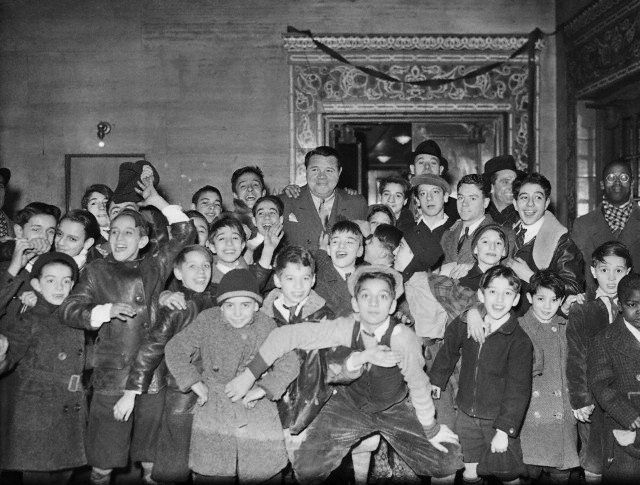
Above: Babe Ruth entertains a rambunctious bunch of children at the Mecca Temple in NYC on December 23, 1935. Do you think they are excited?
Last edited by moira finnie on December 10th, 2008, 7:22 am, edited 1 time in total.
- moira finnie
- Administrator
- Posts: 8024
- Joined: April 9th, 2007, 6:34 pm
- Location: Earth
- Contact:
Hi Christine,
I'm glad that you're getting a kick out of the "Hollywood vs. the Holidays" thread. According to what I've been able to ascertain, Joan is listed in the credits of Proud Flesh (1925) as a "Bit Part" player, so she's probably tough to spot.
Actually, Judith,
There are worse pictures of a struggling Joan, especially during her early years at Metro, when she was floundering around looking for an appropriate screen persona. This one just seemed to capture her tension and toughness, two qualities that just scream "Christmas", no?
I'm glad that you're getting a kick out of the "Hollywood vs. the Holidays" thread. According to what I've been able to ascertain, Joan is listed in the credits of Proud Flesh (1925) as a "Bit Part" player, so she's probably tough to spot.
Actually, Judith,
There are worse pictures of a struggling Joan, especially during her early years at Metro, when she was floundering around looking for an appropriate screen persona. This one just seemed to capture her tension and toughness, two qualities that just scream "Christmas", no?
- moira finnie
- Administrator
- Posts: 8024
- Joined: April 9th, 2007, 6:34 pm
- Location: Earth
- Contact:
The Christmas Album: The Party Scene
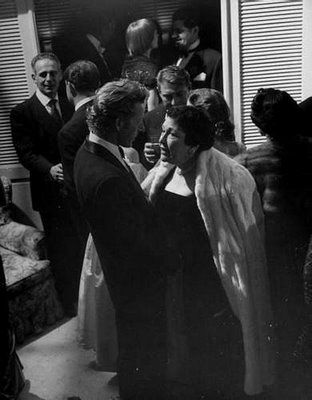
On the Eleventh Day of our tour of Holiday's past we stumble upon a convivial gathering of the bright, the guilty and the talented at a Los Angeles party in December, 1949. Leaning as far back as he possibly can while staying upright is jolly, tensely elfin Danny Kaye, who appears to be absorbed in a deeply philosophical conversation with none other than Louella Parsons, the Hearst newspaper chain's doyenne of all manner of Hollywood gossip. By this time, Louella had been at the game for 35 years when, after writing scripts for Essanay Studios, she branched out, writing one of the first movie-oriented columns in a daily newspaper, the Chicago Record-Herald in 1914. Eventually, she moved on to the bigger pond of William Randolph Hearst's New York American. In between plumping for Hearst's girlfriend, Marion Davies, in her columns, she spent considerable time in California. After an allegedly serious bout of tuberculosis, Parsons moved to the drier West Coast and found a miracle cure there--fame, power and innuendo. As the movie industry grew there, so did her clout. Parsons was eventually carried in 400 newspapers read by 20 million apparently movie-mad subscribers.
The subjects discussed in her newspaper articles, radio show and appropriately named 1944 autobiography, "The Gay Illiterate" often tried to appease the woman, who was known to have spies throughout Hollywood. In one instance Louella published the information that Joan Crawford was filing divorce papers against Douglas Fairbanks, Jr. before Mr. Fairbanks had been told. At other times, Parsons would take a swipe at an individual who had displeased her, for an "aberrant" life-style, a smart mouth or in many cases, for being an especially independent-minded woman in the movies. A few of those who displeased her included Katharine Hepburn who was labeled as "too snobbish" and Myrna Loy, about whom Parsons wrote "she is one of the best-looking girls on the screen, and maybe one of these days her acting will match her looks. Here's hoping!" One of those whose career may actually have been hurt by Louella's public dislike was Ann Harding. In 1931, Parsons wrote that "off the train in Pasadena, Ann Harding shooed away the press like so many flies. Stars who take this attitude often live long enough to step off trains without any waiting newspaper delegation."
Sharp cookies in tinseltown, among them a genuinely grateful Carole Lombard, put in a friendly call to Parsons once a week from 1929 on, and the effusiveness of the gossip monger's public praise for the talented actress did not hurt her career either. At Christmas, many of the fearful and the just cautious in the studios heaped presents upon Louella, seeking to appease the jealous goddess and build up a fund of good will for the coming year. It was also the "politick" thing to do as long as one made sure that her arch-rival, former actress Hedda Hopper, who had turned into an even sharper tongued columnist than Louella, didn't find out that something better had been sent to Parsons. Most extended their generosity to her as well.
According to many reports, at Christmas at the Parsons house nary a surface was left bare of an offering, and maneuvering across the living room heaped with loot toward the glittering Christmas tree was impossible. When Parsons died well past her prime in 1972, one of her obituaries said that "[d]espite her prejudices, her inaccuracies, her tendency to ignore facts when it fitted her purpose, she got her story--often exclusively--by a tough-minded approach that could have a terrifying impact on her subjects. In Hollywood, Miss Parsons...ruled as a queen."
Well, Danny Kaye may be trying to keep his bread buttered by pretending he's listening to Louella's thoughts pour forth. Me, I'm going over in the corner on the left side of this picture to share some less ambitious, but perhaps more mellow cheer with character actor par excellence Paul Stewart.
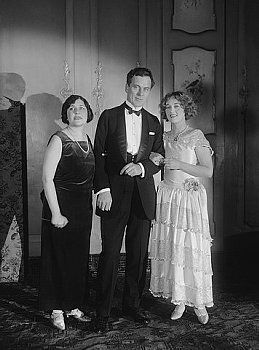
Above: Louella Parsons started early in her climb to the top. Here she is seen in December, 1923 with silent screen star, actor Thomas Meighan and Marion Davies at a ball for disabled veterans hosted by Davies (and her inamorata William Randolph Hearst) at The Plaza in NYC.
- moira finnie
- Administrator
- Posts: 8024
- Joined: April 9th, 2007, 6:34 pm
- Location: Earth
- Contact:
The Christmas Album: Dolores del Río
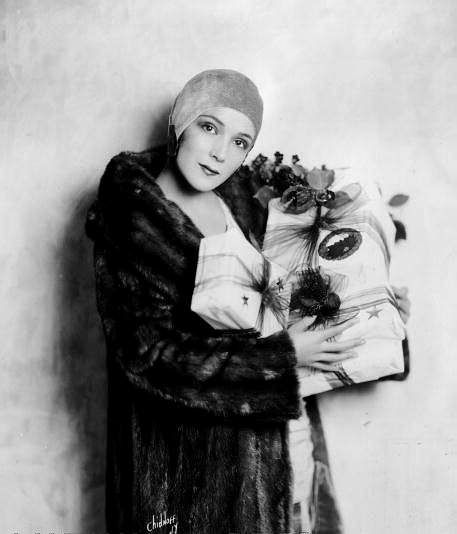
It's Day Twelve of our schussing through the Holidays and we've landed feet first around 1925, just in time to greet a woman who could combine a smoldering hot house beauty with an exquisitely doll-like, elegant delicacy strengthened by her natural dignity. The lady is Dolores del Río, just as she entered pictures in America in the mid-20s. With her luxurious fur coat, the cloche hat, and elegantly wrapped presents, the subject of this photographic portrait, born Dolores Martínez Asúnsolo y López Negrete, would seem a natural for a film set in a snowy clime--at least to some in Hollywood.
In reality, the actress was from an aristocratic Mexican family of Spanish-Basque descent who had lost most of their assets in the upheaval of the Mexican Revolution in the early 20th century--which might be one reason why Dolores has a slightly quizzical tilt of her head in this artificial setting. After an early marriage at 16 to wealthy Jaime Del Río of Mexico City, the actress arrived in Hollywood after being discovered by American film director Edwin Carewe.
She soon caught the eye of the discerning, and became a WAMPAS Baby of 1926, (along with Mary Astor, Janet Gaynor and Joan Crawford), and had a solid international hit under Raoul Walsh's direction as Charmaine in the original What Price Glory (1926) and in another film, The Loves of Carmen (1927) as well as Ramona (1928), directed by Carewe. Though divorced from her first husband, his tragic death from blood poisoning in 1928 freed her psychologically to marry again, (as well as assuaging her Catholic conscience). In 1930, as the movies took their first baby steps away from the silents, she married MGM's powerful and talented art director and production designer, Cedric Gibbons.
Her presence in talkies took off in the early '30s, when young David O. Selznick, a producer at RKO announced to his minions that he wanted "del Rio and McCrea in a South Sea romance...I don't care what story you use so long as we call it Bird of Paradise and del Rio jumps into a flaming volcano at the finish." A scandal to the censors and still one of the most rapturous nods to the overpowering combination of physical beauty and the camera, this movie is justly regarded as a fairly ludicrous if engaging miscegenation drama, but a boffo star vehicle for celebrating the sensual glory of del Rio and McCrea as "children of nature." For dizzying silliness, nothing in Bird of Paradise (1932) could match some of the other entertaining films with Dolores del Rio.
Some faves from "the foolish but wonderful" file for this viewer would be Flying Down to Rio (1933) with Gene Raymond showing unusual signs of life when in del Rio's presence, In Caliente (1935) with a frisky Pat O'Brien sparked by del Rio's palpable sexiness, Madame Du Barry (1934) with Dolores as an acquisitive but perhaps caring mistress of Reginald Owen's Louis XV. The madcap capers reached their apotheosis in the especially loopy Wonder Bar (1934), with all kinds of pre-code naughtiness going on in Al Jolson's Parisian art deco nightspot, led by the dancing Dolores' faithless character of "Inez", whose burning eyes and flirtatious ways vexed her consort, Ricardo Cortez, who crankily played "Harry the Gigolo".
Renowned for her preternatural beauty, as time went by Dolores' life--at least if you believe the movie magazines--seemed to be composed largely of maintaining that increasingly remote beauty, by allegedly sleeping 16 hours a day, a diligent diet and other arcane and complicated regimes.
In the 1940s, after appearing in Journey Into Fear (1942) and several public occasions with wunderkind Orson Welles, del Rio divorced Gibbons. During this same period, her screen presence began to seem more otherworldly and stately, with nary a wisp of her former sparkling fire on screen. Among her notable film roles in English speaking movies would be as a serene madonna in John Ford's beautifully photographed if slow moving adaptation of Graham Greene's The Fugitive (1948) and as a Spanish Woman in the drama about the treatment of the American Indian in Cheyenne Autumn (1964).
While appearances in Spanish language films became increasingly important for Dolores, some viewers might also mention that she played Elvis Presley's mother in Flaming Star (1960), but I wouldn't be one of those who wanted to recall that lowlight in movie history. Del Rio's final years, after beginning a third marriage in the '50s that lasted until her death, are said to have been mostly devoted to charity, concentrating on promoting Mexico's cultural heritage, the protection of children, and her quiet efforts to support gays, Latinos and minorities in the film industry in the U.S. and abroad. As a Latina actress, del Rio's lasting significance may be that, unlike her contemporary Lupe Velez and other Hispanic actresses working in her lifetime, such as Katy Jurado, she was able to transcend the racial stereotyping that often plagued those women in American movies. Indeed, her seraphic yet sultry and enigmatic beauty gave her the power to surpass ethnicity and to touch audiences to this day. As one scholar noted, "[h]ers was a vague upper class exoticism articulated...within a tragic sensuality"
- moira finnie
- Administrator
- Posts: 8024
- Joined: April 9th, 2007, 6:34 pm
- Location: Earth
- Contact:
The Christmas Album: Ronnie
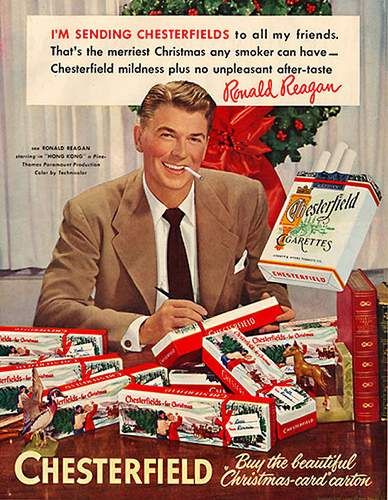
Well, well, if it isn't the Ghost of Christmas Past on Day Thirteen of our Holiday tour! It has come wrapped in the form of vices that were once merely regarded as a mildly interesting form of normal social intercourse. And who should we find hawking our nation's former favorite habit, but Ronald Reagan himself, passing out the smokes to all and sundry from his desk. I'd say it was around 1952 from the small print mentioning a forgotten but pleasant adventure flick called Hong Kong (1952) aka Bombs Over China and from the looks of that baggy brown suit the future pres is wearing, (a color and type that he persisted in wearing forever, it seems). Ah, there's nothing quite like making the world a bit safer for non-Communist smokers. Of course, nowadays, capitalist countries are among the leaders in making the wares of such manufacturers socially anathema, believing that playing nanny over the citizenry might avert humanity's tendencies toward self-destructive behavior.
Things seemed simpler back in Reagan's day, when doctors even made ads endorsing certain brands of cigarettes, claiming that it has "no unpleasant after-taste", and "won't cut your wind" when cheerleading for the big tobacco companies. What would old movies be without cigarettes? Since the production code made more explicit expressions of passion impossible, and since big tobacco companies practiced product placement of their goods by readily supplying the studios with them, sharing a smoke on and off screen certainly gave actors "something to do with their hands" and, oh, that curling smoke certainly photographed beautifully in black and white.
Speaking of black and white, Mr. Reagan, before he took on the ultimate role as president of the United States, tried to make his mark on the public consciousness via many a Warner Brothers movie. This viewer doesn't think he was as poor an actor as some claim, and his film career is much pleasanter to contemplate than politics. This is especially so in such innocent fare as those "Boy's Life" visions encapsulated in movies such as Brother Rat (1938), his heart-tugging "Gipper" in Knute Rockne, All American (1940), and Desperate Journey (1942) with his double-talking spiel confusing Nazi Raymond Massey as he, Errol Flynn and other members of the Warner Brothers stock company broke out of Germany. The less innocent, more ambitious movies that he appeared in were not always successful, but they did give a more nuanced look at life through the Hollywood lens. Some of the best of them for this viewer were those films that presented his appealing squareness in all its embattled poignancy. The most effective might be his maimed small towner in the very dark Sam Wood film of King's Row (1942), his tentative romantic looking for a way to feeling whole again in The Voice of the Turtle (1947), his stalwart comrade in arms in the unjustly forgotten The Hasty Heart (1949), his withdrawn, epileptic scientist in the intriguingly flawed Night Unto Night (1949) and the not so innocent but quite interesting re-imagining of Hemingway's The Killers (1964).
As for appearing in advertisements such as the above, Reagan, whose letters and diaries reveal a much more astute and contemplative person than he ever revealed publicly, once pointed out to those eager to emphasize his failings, that "You know, by the time you reach my age, you've made plenty of mistakes if you've lived your life properly." As for his political career, I like the rather myopic Hollywood approach attributed to Reagan's former boss, Jack Warner, when he heard that his onetime employee, who had been a president of SAG for several years, was considering a serious run for gubernatorial office in California:"No, no, no, no. You've got it all wrong. Jimmy Stewart for governor, Ronald Reagan for best friend."
- charliechaplinfan
- Posts: 9040
- Joined: January 15th, 2008, 9:49 am
- moira finnie
- Administrator
- Posts: 8024
- Joined: April 9th, 2007, 6:34 pm
- Location: Earth
- Contact:
The Christmas Album: Jimmy

We've reached the Fourteenth day of our hegira through the Holidays, and find ourselves in 1957, long before most of us automatically associated the name of James Stewart with Christmas. Here he's looking rather endearingly tentative, wearing those horn rims and scuffed shoes while rehearsing a frontier-style adaptation of A Christmas Carol for tv's General Electric Theater in a show called "The Trail to Christmas".
I suspect that back then, Jimmy, who is seen above with child actor Dennis Holmes as a polio stricken Tiny Tim, was best known as Hollywood's version of "a regular guy". Despite those deeply ambivalent and gritty Anthony Mann Westerns such as Winchester '73 (1950), The Man From Laramie (1955), an occasional appearance as June Allyson's spouse in such popular fare as The Glenn Miller Story (1954) and in some fairly racy Hitchcock flicks, he seemed less of an icon than now. A few probably still cherished his pixelated turn in Harvey(1950), a role that caught the man's sweet and gentle vagueness rather well, (even though he was never satisfied with his playing of the role on film).
After It's a Wonderful Life (1946) fell into the public domain and started to show up on the tube non-stop around Christmas, things changed. Now, of course, you might feel lucky if you can avoid a day in December when Mr. Stewart isn't appearing on the box in that movie, The Shop Around the Corner (1940), or perhaps, Mr. Krueger's Christmas* (1980).
Today, Stewart may be one of the most revered of the stars of the classic era. I suspect that a random comment he made, reportedly tossed off sotto voce during the filming of Anatomy of a Murder (1959), might have been closer to his own assessment of his career and Hollywood. Being up in northern Michigan during the location shooting for the Otto Preminger drama, he decided that he'd do a little fishing in his spare time. Using the large, makeshift dressing room shared by the whole cast to don his angling gear, he listened quietly to a particularly breathy starlet expounding on her burgeoning career prospects. Picking up his hip boot waders, Stewart murmured to another person out of the corner of his mouth as he pulled on the boots, "I advise you get a pair of these, because we're in it up to our asses."
The above picture also makes this viewer think of the fact that most of us under 50 have no memory of polio, thanks to Jonas Salk and the other medical researchers who worked for decades to obliterate this scourge. Today, one occasionally meets an older adult with the traces of this still mysterious affliction. To a 1957 audience however, it may have brought a stab of fear associated with summer outbreaks, of FDR, of the March of Dimes, and first hand knowledge of the effect of this disease on those they knew and loved, as well as on themselves. Today our world sometimes seems to be about to break under the weight of all our problems. Maybe we should take a moment to remember that while realistically, it seems that much of our daily petty pace is pretty futile, occasionally, the work of many and the insights of one individual can make a difference for the better as well as the worse. Just by putting one foot in front of the other, no matter how clumsily. Or maybe I'm just getting soft looking at Stewart.
____________________
*If you don't know the short, Mr. Krueger's Christmas, you might like it. It is a surprisingly affecting 25 minute film about a lonely janitor that Stewart appeared in late in his career. It can be seen in its entirety here
- moira finnie
- Administrator
- Posts: 8024
- Joined: April 9th, 2007, 6:34 pm
- Location: Earth
- Contact:
